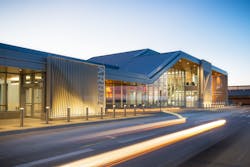Garden City Airport: A New Terminal That Reflects Community and Innovation

In May 2024, Garden City Regional Airport (GCK), located in the heart of southwestern Kansas, opened its newly expanded terminal, marking the largest project in the airport’s history. Designed to meet growing passenger demand and reflect the diverse local community, the new 27,000-square-foot facility represents more than just an infrastructure upgrade—it’s a symbol of progress and connection for the entire region.
The terminal expansion addresses several needs, from increased capacity to advanced amenities for both passengers and non-travelers alike. More importantly, it embodies Garden City’s values by integrating elements that reflect its agricultural roots and cultural diversity.
“We wanted the new terminal to reflect who we are as a community,” said Rachelle Powell, Director of Aviation at Garden City Regional Airport. “It was important that every detail, from the architectural design to the functionality, not only meets current and future demand but also makes passengers feel welcomed and at home.”
This new terminal is built for the future, with modern features and an expanded capacity to accommodate up to 100,000 passengers annually. The project also came in $2.5 million under its initial budget of $26.6 million, a testament to effective planning and collaboration between the airport, designers, and contractors.
A New Terminal for the Future
The need for a new terminal was driven by the outdated infrastructure of the previous terminal, which was originally built in 1959. Over time, passenger traffic doubled, putting a strain on the single-gate facility that was never designed to handle such demand. As American Airlines aimed to bring in larger aircraft, the limitations of the old terminal became even more apparent.
“Our old terminal simply couldn’t keep up,” Powell explained. “It was built in a different era, and while it had served us well, we needed a facility that could meet modern passenger needs and allow us to grow.”
The old terminal, with its solid brick structure, presented significant challenges for expansion. Ultimately, after a thorough terminal area plan study, it became clear that a new facility would be the most cost-effective solution to meet the airport's long-term needs.
The decision to move forward with a brand-new terminal wasn’t just about increasing capacity. It was about creating a welcoming space for the diverse population of Garden City, a community enriched by multiple cultures and languages. The airport leadership, along with design firm HNTB, collaborated closely to ensure the new terminal reflected these values.
“Our community is very diverse,” Powell noted. “We have a large agricultural base, and over the years, we’ve welcomed refugees and immigrants from all over the world. It was important that the terminal reflected that inclusivity.”
A Small Airport with Big Amenities
While the focus of the terminal's design was on community and comfort, technology played a significant role in enhancing operational efficiency and the passenger experience. One of the most notable features is the integration of intuitive wayfinding throughout the terminal. Inspired by the historic tetrahedron wind direction indicator located next to the runway, the design team incorporated subtle triangular shapes throughout the terminal to guide passengers without overwhelming them with signage.
“We didn’t want the terminal to feel cluttered,” explained Allison Hawk, a senior project designer at HNTB. “By integrating signage into architectural elements, such as using the fascia of lobby halo lights for directional signage, we were able to create a clean, open design that’s easy to navigate.”
Another technological improvement is the ticketing area, where a recessed baggage scale allows passengers to effortlessly roll their luggage onto the scale. This small yet impactful feature enhances efficiency and convenience for both travelers and airport staff.
“We wanted to make sure the terminal provided the same level of comfort and functionality as larger airports,” said Ryan Shropshire, project manager at HNTB. “From seating 100% of passengers in the holdroom to ensuring outlets were readily available, we focused on the little details that improve the overall experience.”
The payoffs from this project are already becoming evident, not only in terms of functionality but also in the impact on the local economy. The new terminal has doubled the airport's capacity, allowing it to handle up to 100,000 passengers annually. The additional capacity, combined with the flexibility built into the design, positions the airport to attract a second large commercial carrier in the future.
"We’ve already seen a positive response from the community," Powell shared. "Passenger numbers continue to rise, and the new terminal is helping us market the region more effectively."
Economic development leaders in Garden City are using the new terminal as a key selling point when courting businesses. With easy access to Dallas and potential connections to the rest of the world, the airport is seen as a gateway to attracting new industries to the region.
Beyond the economic benefits, the terminal has become a popular destination for non-travelers as well. The second-floor landside restaurant, Flight Deck, offers sweeping views of the runway, providing a unique space for locals to dine and watch planes take off and land. The restaurant also serves as an event space, adding another layer of functionality to the terminal.
“We wanted to retain that hometown feel,” Hawk explained. “The previous terminal had a popular restaurant where locals loved to gather and watch planes. The new space builds on that tradition, making the airport a community hub, not just a place for travelers.”
Lessons Learned
One of the key takeaways from this project was the importance of communication and collaboration at every stage. The two-phase construction process allowed the airport to remain operational throughout the project, which was a significant challenge given that the new terminal was being built on the site of the existing facility.
“Keeping the airport fully operational while building a new terminal in the same footprint was no easy task,” Shropshire acknowledged. “We worked closely with the contractor to ensure that phasing was done in a way that minimized disruption.”
In the first phase, departure activities were moved to a temporary modular trailer on the airfield apron, while the security checkpoint remained in its original location. This allowed the construction team to focus on completing the departure sequence, including check-in, security, and holdroom facilities. In the second phase, arrival processes were completed, including the addition of Gate 2, a baggage carousel, and rental car facilities.
Powell highlighted the importance of flexibility in both the design and construction phases. “There were moments when we had to adapt quickly,” she said. “For example, we made adjustments to improve passenger flow, and our contractor’s innovative use of simple facilities like shipping containers as temporary spaces kept everything running smoothly.”
Looking back on the project, Powell emphasized the leadership lessons she gained throughout the process. “This was my first time managing a terminal project, and it taught me the value of listening and learning from every stakeholder,” she reflected. “It was all about making sure the terminal functioned well for both passengers and staff.”
The new Garden City Regional Airport terminal is designed to be more than just a modern facility—it’s a reflection of the region’s values, a hub for economic development, and a gateway to the future. From its seamless design to the thoughtful incorporation of technology and amenities, the terminal stands as a testament to what can be achieved through collaboration and innovation.
As Garden City continues to grow, the new terminal ensures that the airport is ready to meet the demands of tomorrow while staying rooted in the values that make this community special.
About the Author
Joe Petrie
Editor & Chief
Joe Petrie is the Editorial Director for the Endeavor Aviation Group.
Joe has spent the past 20 years writing about the most cutting-edge topics related to transportation and policy in a variety of sectors with an emphasis on transportation issues for the past 15 years.
Contact: Joe Petrie
Editor & Chief | Airport Business
+1-920-568-8399
>> To download the AviationPros media kits, visit: Marketing Resource Center
>>Check out our aviation magazines: Ground Support Worldwide | Airport Business | Aircraft Maintenance Technology
